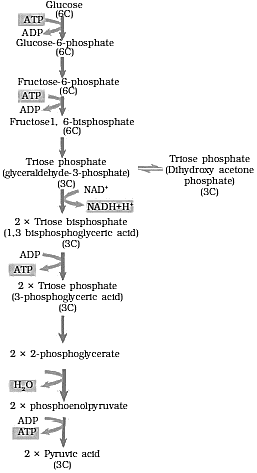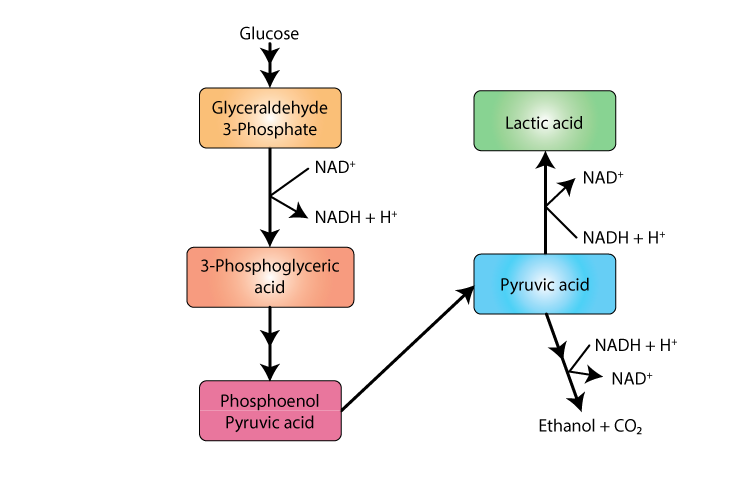According to the CBSE Syllabus 2023-24, this chapter has been renumbered as Chapter 12.
Do Plants Breathe?
Plants, just like most other organisms on earth, use oxygen, and as a result, plants breathe. However, they don’t breathe as most animals do, as plants do not have organs dedicated to the process of gaseous exchange. Instead, they have organelles called stomata and lenticels for this purpose.
Respiration in Plants
Plants perform photosynthesis to create sugars (such as glucose). This, along with oxygen, is used to produce energy which is used in the plant’s growth. This process of respiration is essentially the process of photosynthesis but in reverse.

See Also: Important Questions for Class 11 Biology-Respiration in Plants
Glycolysis
The scheme of glycolysis is often referred to as the EMP pathway. Glycolysis is the only process in respiration taking place in anaerobic organisms. This process takes place in the cytoplasm of the cell and is found in all living entities wherein glucose undergoes partial oxidation forming two molecules of pyruvic acid.

In-depth study: Glycolysis
Fermentation
In this process, incomplete oxidation of glucose is obtained under anaerobic conditions by a set of reactions resulting in the conversion of carbon dioxide to ethanol, reactions catalyzed by enzymes – alcohol dehydrogenase, pyruvic acid decarboxylase. The various steps involved in fermentation are as follows:

Aerobic Respiration
In this process, the complete oxidation of organic substances takes place in the presence of oxygen, releasing water, carbon dioxide and an enormous amount of energy found in the substrate. Aerobic respiration is most commonly found in higher organisms. For it to occur inside the mitochondria, the ultimate product of glycolysis, pyruvate is moved from the cytoplasm into the mitochondria. Some important events taking place are:
- complete oxidation of pyruvate, leaving 3 molecules of CO2
- passing electrons eliminated as part of hydrogen atoms to molecular oxygen with a parallel synthesis of ATP
Electron Transport System(ETS) and Oxidative Phosphorylation
Found in the inner mitochondrial membrane, the electron transport system(ETS) is the metabolic pathway through which electrons pass from one carrier to another. The illustration below provides more details.

Comparison Between Fermentation and Aerobic Respiration
- Where aerobic respiration is the complete degradation of carbon dioxide and water, fermentation results in the partial breakdown of glucose only
- Aerobic conditions lead to the formation of several molecules of ATP, whereas the net gain of only two molecules of ATP is observed for each molecule of glucose degraded to pyruvic acid in the process of fermentation.
- In fermentation, NADH is oxidized to NAD+ slowly, whereas this same reaction is vigorous under aerobic conditions.
Respiratory Quotient
The respiratory quotient(RQ) can be defined as the ratio of the volume of carbon dioxide evolved to the volume of oxygen consumed in the process of respiration. It is also referred to as the respiratory ratio. This ratio is dependent on the type of respiratory substrate utilized during respiration. The RQ will be 1 when carbohydrates are utilized as substrates and are oxidized completely. This is as equal amounts of carbon dioxide and oxygen are evolved and consumed.
Also Read, Respiratory quotient
Important Questions for Respiration in Plants
- What is meant by Glycolysis?
- Explain Krebs Cycle
- Schematically illustrate Glycolysis
- What is aerobic respiration?
- Define Fermentation
- Explain oxidative phosphorylation
- Differentiate between fermentation and glycolysis.
| Also Access |
| NCERT Solutions for Class 11 Biology Chapter 14 |
| NCERT Exemplar for Class 11 Biology Chapter 14 |
To explore more questions or concepts about respiration in plants class 11 notes, register at BYJU’s.
Further Reading:-
| Light Dependent Reactions | Calvin Cycle |
Frequently Asked Questions on CBSE Class 11 Science Notes Chapter 14 Respiration in Plants
What are the steps in the fermentation process?
The four stages of fermentation are:1. Inoculum Preservation 2. Inoculum Build-up 3. Pre-Fermenter Culture 4. Production Fermentation.
What is glycolysis?
A process in which glucose (sugar) is partially broken down by cells in enzyme reactions that do not need oxygen.
What is the respiratory quotient?
The respiratory quotient can be defined as the ratio of the volume of carbon dioxide evolved to the volume of oxygen consumed in the process of respiration.
Comments